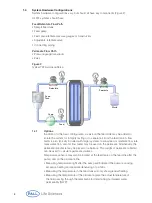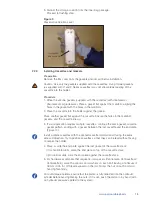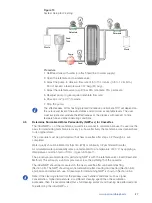
Procedure
1. Add a volume of water to the feed tank equal to at least 4 system
hold-up volumes.
2. Open the retentate and permeate valves. Direct retentate and permeate lines into
the feed tank.
3. Adjust the pump to deliver the retentate flow rate that will be used in the process
and circulate the water for a few minutes through the system until no more air
bubbles are seen exiting from the permeate line. If necessary, add additional water
to the feed tank to prevent air from being pulled into the feed line.
4. Direct the retentate line to drain and pump out water just until air is about to be
pulled into the feed line. Then return the line to the feed tank. If air is pulled in, add
just enough water to the feed tank so that no air gets drawn into the lines at the
required flow rate.
5. Stop the pump.
6. Close the permeate valve.
7. Remove and hold the permeate line up.
8. Direct the retentate line to a graduated cylinder and slowly pump out the remaining
water in the system, allowing air to purge out the lines.
9. Fill the permeate line with water from the cylinder.
10. Record the volume collected in the graduated cylinder.
To determine the Minimum Working Volume, add the Non-recoverable volume (X) to
the Volume Collected in the graduated cylinder (Y).
Table 9
Minimum Working Volume Calculation Chart
Volume in Graduated
Cylinder
Y
________ mL (Y)
Non-recoverable Volume
from Table 8
X
+
________ mL (X)
Minimum Working Volume X
+ Y = ________ mL (Z)
4.
Preconditioning T-Series Cassettes and Systems
Before processing product, several steps must be performed (Figure 14) to assure that the cassettes
are properly installed in the holder and fit-for-use to prevent possible sample loss or contamination from
storage agents. This preconditioning process consists of six steps:
Figure 14
Steps for Preconditioning T-Series Cassettes
www.pall.com/biopharm
21
Step
Optimization or
Processing Mode
5
Integrity
Test
6
Buffer
Condition
4
Determine
NWP
3
WFI Flush
2
Sanitize
1
WFI Flush
Determining
Hold-up
Volume
Install
Cassettes
















































